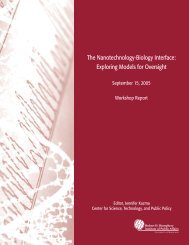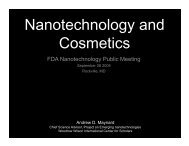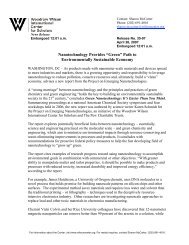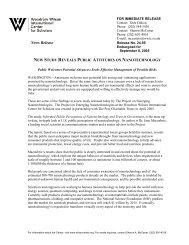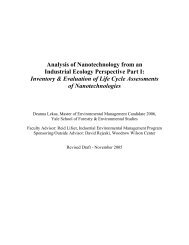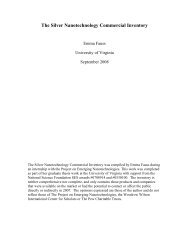nanotechnology oversight - Project on Emerging Nanotechnologies
nanotechnology oversight - Project on Emerging Nanotechnologies
nanotechnology oversight - Project on Emerging Nanotechnologies
You also want an ePaper? Increase the reach of your titles
YUMPU automatically turns print PDFs into web optimized ePapers that Google loves.
EXECUTIVE SUMMARY<br />
Few domestic policy areas that the new<br />
administrati<strong>on</strong> must address will have greater<br />
l<strong>on</strong>g-range c<strong>on</strong>sequences than <str<strong>on</strong>g>nanotechnology</str<strong>on</strong>g>—a<br />
new technology that has been compared<br />
with the industrial revoluti<strong>on</strong> in terms<br />
of its impact <strong>on</strong> society. If the right decisi<strong>on</strong>s<br />
are made, <str<strong>on</strong>g>nanotechnology</str<strong>on</strong>g> will bring vast<br />
improvements to almost every area of daily<br />
living. If the wr<strong>on</strong>g decisi<strong>on</strong>s are made, the<br />
American ec<strong>on</strong>omy, human health and the<br />
envir<strong>on</strong>ment will suffer.<br />
Nanotechnology can have a major impact<br />
<strong>on</strong> many of the most important problems facing<br />
the United States. It can reduce dependence<br />
<strong>on</strong> foreign oil, help deal with global climate<br />
change, improve the country’s health<br />
system, strengthen nati<strong>on</strong>al defense, help<br />
fight terrorism and make a major c<strong>on</strong>tributi<strong>on</strong><br />
to the nati<strong>on</strong>al ec<strong>on</strong>omy. Nanotechnology<br />
is also important as a prototype of<br />
the technological opportunities and challenges<br />
that will characterize the 21st century.<br />
The country needs to learn how to deal with<br />
potential adverse c<strong>on</strong>sequences of new technologies<br />
and how to make sure the technologies<br />
best serve society’s needs.<br />
The existing laws and instituti<strong>on</strong>s for dealing<br />
with nano and other technologies are weak<br />
and inadequate. The <str<strong>on</strong>g>oversight</str<strong>on</strong>g> system needs to<br />
be repaired. The regulatory agencies lack<br />
resources, some to the point of being n<strong>on</strong>functi<strong>on</strong>al.<br />
The laws have huge gaps and,<br />
more often than not, fail to protect the public.<br />
Nanotechnology highlights these inadequacies<br />
and provides an opportunity to act <strong>on</strong> them.<br />
This report is a blueprint for what should<br />
be d<strong>on</strong>e about <str<strong>on</strong>g>nanotechnology</str<strong>on</strong>g> in the first few<br />
m<strong>on</strong>ths of the new administrati<strong>on</strong>. It c<strong>on</strong>tains<br />
more than 35 recommendati<strong>on</strong>s. The following<br />
acti<strong>on</strong>s are necessary:<br />
• Maximize the use of existing laws:<br />
Although the laws for <str<strong>on</strong>g>nanotechnology</str<strong>on</strong>g> <str<strong>on</strong>g>oversight</str<strong>on</strong>g><br />
need to be changed, much can be d<strong>on</strong>e<br />
within existing authorities. Nanomaterials<br />
should be defined as “new” substances under<br />
the Toxic Substances C<strong>on</strong>trol Act (TSCA)<br />
and the cosmetics, food additive and food<br />
packaging provisi<strong>on</strong>s of the Federal Food,<br />
Drug, and Cosmetic Act (FFDCA), thereby<br />
enabling the Envir<strong>on</strong>mental Protecti<strong>on</strong><br />
Agency and the Food and Drug<br />
Administrati<strong>on</strong> to c<strong>on</strong>sider the novel qualities<br />
and effects of nanomaterials. The federal<br />
pesticide law should be enforced for nano<br />
anti-microbial products such as clothing and<br />
household appliances that use nanosilver.<br />
Existing regulati<strong>on</strong>s of the Occupati<strong>on</strong>al<br />
Safety and Health Administrati<strong>on</strong> should be<br />
used to protect workers from nanoparticles<br />
in the workplace.<br />
• Increase research <strong>on</strong> the risks posed by<br />
nanomaterials: Federal spending to understand<br />
the potential risks posed by nanomaterials<br />
is inadequate. Results of the limited<br />
testing that has been d<strong>on</strong>e provide reas<strong>on</strong> for<br />
c<strong>on</strong>cern: carb<strong>on</strong> nanotubes can irritate lungs<br />
in a way similar to asbestos; some nanomaterials,<br />
when tested <strong>on</strong> rats, pass from nerve<br />
endings in the nose to the brain, bypassing<br />
the blood-brain barrier; and some nanomaterials<br />
can interact with DNA. These substances<br />
could have widespread negative<br />
impacts—not <strong>on</strong>ly <strong>on</strong> the envir<strong>on</strong>ment and<br />
human health but <strong>on</strong> c<strong>on</strong>sumer c<strong>on</strong>fidence<br />
as well. Risk research is essential.<br />
• Enact changes to existing <str<strong>on</strong>g>oversight</str<strong>on</strong>g> laws:<br />
Laws such as TSCA and FFDCA, which<br />
cover adverse effects of nanomaterials,<br />
v



